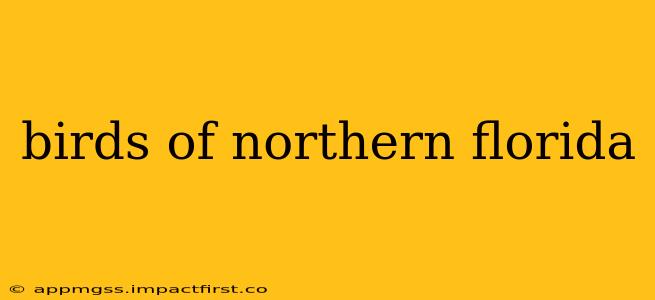Northern Florida boasts a rich avian diversity, attracting birdwatchers from around the globe. From the coastal marshes to the inland forests and sprawling grasslands, a vast array of feathered friends call this region home. This guide explores the fascinating birdlife of Northern Florida, highlighting key species and providing insights into their habitats and behaviors. Whether you're a seasoned birder or a curious newcomer, this comprehensive overview will equip you with the knowledge to identify and appreciate the incredible biodiversity of this unique region.
What are some common birds found in Northern Florida?
Northern Florida's diverse habitats support a wide range of bird species. Some of the most common birds you'll encounter include:
- Brown Pelicans: These magnificent birds are a common sight along the coast, soaring effortlessly above the waves.
- Great Blue Herons: Often found wading in shallow waters, these large birds are easily identifiable by their size and bluish-gray plumage.
- White Ibis: With their striking white feathers and curved bills, these birds are frequently seen foraging in marshes and wetlands.
- Northern Cardinals: These vibrant red birds are a year-round resident, their cheerful songs echoing through backyards and forests.
- Blue Jays: Known for their intelligence and boisterous calls, blue jays are a common sight in various habitats.
- Mourning Doves: Their soft, melancholic cooing is a familiar sound throughout the region.
- Red-bellied Woodpeckers: Though their bellies aren't actually bright red, these woodpeckers are easily recognizable by their red nape and distinctive call.
- Carolina Wrens: These tiny birds are known for their loud, buzzing songs and energetic movements.
- Eastern Phoebes: These flycatchers are common near streams and woodlands, often perching on branches and snatching insects in mid-air.
What birds migrate through Northern Florida?
Northern Florida serves as a crucial stopover point for many migratory birds traveling along the Atlantic Flyway. During the spring and fall migrations, you can expect to see a significant increase in bird diversity, including:
- Warblers: Numerous warbler species, with their diverse colors and patterns, pass through during migration.
- Tanagers: These brightly colored birds add splashes of vibrant color to the landscape.
- Orioles: Baltimore Orioles and Orchard Orioles are stunning sights during their migratory journeys.
- Swallows: Various swallow species can be observed in large flocks as they migrate.
- Shorebirds: Many shorebird species utilize Florida's coastal areas as important resting points during their long migrations.
What are the best places to birdwatch in Northern Florida?
Numerous locations in Northern Florida offer excellent birdwatching opportunities. Some of the top spots include:
- St. Marks National Wildlife Refuge: This expansive refuge offers diverse habitats, including marshes, forests, and beaches, supporting a rich variety of bird species.
- Talquin Bay: Known for its abundant waterfowl and wading birds, this area is ideal for birding enthusiasts.
- Lake Woodruff National Wildlife Refuge: This refuge protects significant wetland habitats and supports numerous bird species.
- Ocala National Forest: This vast forest provides opportunities to spot a variety of woodland birds.
- Amelia Island: This coastal island is known for its excellent shorebird viewing opportunities.
What time of year is best for birdwatching in Northern Florida?
While birds can be spotted year-round, the best time for birdwatching in Northern Florida is during the spring and fall migrations (March-May and September-November). During these periods, you'll have the chance to see a much greater diversity of species. Winter offers the opportunity to observe resident birds, and summer provides a chance to see nesting birds and their young.
What equipment do I need for birdwatching in Northern Florida?
To enhance your birdwatching experience, consider using the following equipment:
- Binoculars: Essential for getting a closer look at birds.
- Field guide: A helpful tool for identifying birds you encounter.
- Camera (optional): To capture stunning photos of the birds you see.
- Hat and sunscreen: To protect yourself from the Florida sun.
- Insect repellent: To ward off mosquitoes and other biting insects.
- Comfortable walking shoes: For exploring various habitats.
Where can I find more information about birds of Northern Florida?
Numerous resources are available for learning more about the birds of Northern Florida. Local Audubon societies, nature centers, and online databases such as eBird offer valuable information and opportunities for connecting with fellow bird enthusiasts.
By exploring these locations and employing these strategies, you can embark on a rewarding journey into the fascinating world of Northern Florida's avian inhabitants. Remember to always respect wildlife and their habitats, leaving no trace behind. Happy birding!
